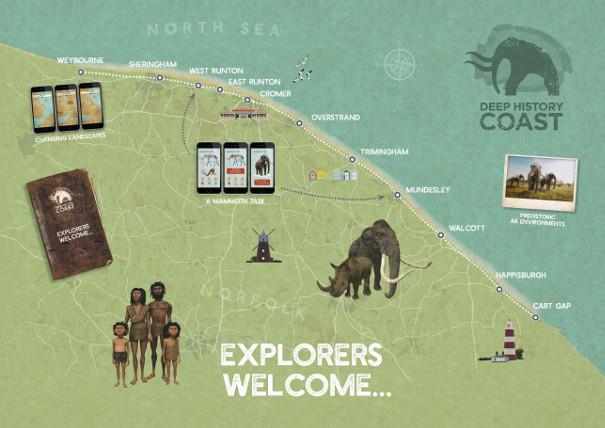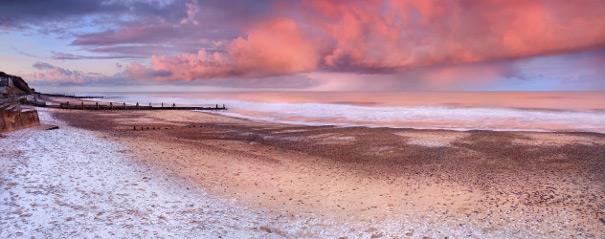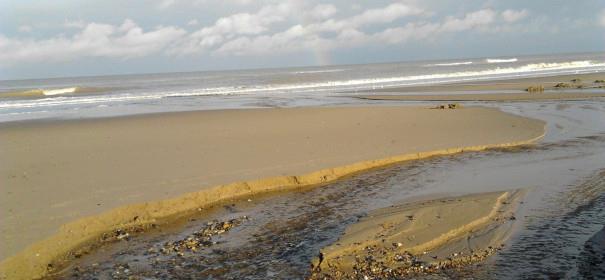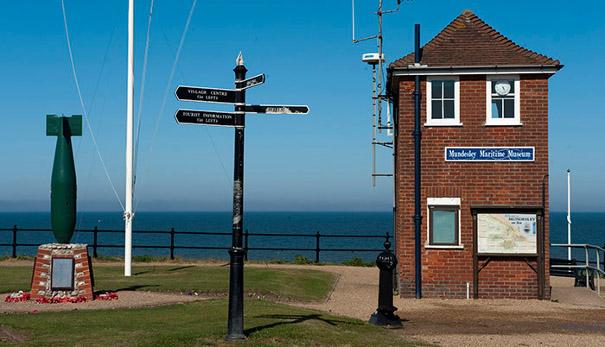North Norfolk's Deep History Coast is a 22-mile stretch of coastline between Weybourne and Cart Gap and is steeped in millions of years’ worth of history. With wonderful beaches, ideal for fossil and artefact hunting and a fascinating Discovery Trail, with fact revealing Discovery Points along the way, there is a lot to discover. There is a free downloadable Deep History Coast App to bring the trail to life linking with the Discovery Points along the way with information and interactive activities.
Through the app, you’ll be able to see the past come back to life and find out what life in Doggerland was like through the eyes of a hominin family, watch animals from 800,000 years ago roam the land and find out the names of any fossils you may find. Discovery Points are located at each of the main villages and towns. Here we focus on Mundesley.

ABOUT MUNDESLEY
Mundesley is a traditional, small seaside village along the Deep History Coast; the perfect spot for a traditional bucket and spade holiday. Like Cromer, the village became popular with the Victorians, when the opening of the railway in 1889 enabled visitors to come to the area. Mundesley has a wide sandy beach, with colourful beach huts and shallow rock pools; it's an ideal playground for children of all ages, and there is also great year-round sea fishing. The beach has lifeguards in the summer season.

EARLY HISTORY
Mundesley has an entry in the Domesday Book of 1085, with the town's name recorded as Muleslai. The main landholder was William de Warenne. During and after the Second World War, sailors and volunteers cleared the North Sea of mines and the village war memorial is dedicated to them. Its war history also includes a gun emplacement, which now stands near the edge of the cliff due to coastal erosion.
The war took its toll on the village’s historic golf course (built in 1901), which was designed with the help of six-times Open champion Harry Vardon. Vardon convalesced at a nearby sanitorium while recovering from tuberculosis and it is said that he scored his only hole-in-one on what is now the sixth. The course was reduced to nine holes when land was required for wartime farming.

DEEP HISTORY
Today, Mundesley village is within an Area of Outstanding Natural Beauty on the Deep History Coast Trail with a Discovery Point by the beach which provides visitors with lots of interactive information about how the area looked millions of years ago. You can find out about how one of the largest mammoth leg bones was discovered at Mundesley beach. Download the App to find out more about the area's history, as well as play games and identify any fossils you find along the beach.
From Mundesley you can follow the coastal path to Walcott or Trimingham and find out more about the coastline. Mundesley grew up by the little River Mun, which flows east around the end of the Cromer Ridge. The ridge ends abruptly just west of the village, and as you stand on the beach here and look over to the high cliffs of Trimingham you can see where the North Sea has sliced it off.
A million years ago two much bigger rivers also came out at the sea just south of Mundesley, one of them the Thames, which headed north east across what is now East Anglia to end up here. Mammoths and rhinoceros, hippos and deer roamed the estuary edges and their fossils discovered as the sea wore away at the base of the cliffs. The finds helped to piece together a picture of a lush landscape which must have felt very like the African savannah.

THINGS TO DO IN MUNDESLEY
The village has tea rooms, shops, pubs and cafe, plus a crazy golf course on the seafront. There’s a play area backing onto the village centre car park, where there are also public toilets. There’s easily plenty to do for the day and the chance to set up a base in one of the beach huts along the prom which can be hired through North Norfolk District Council.
At the top of the beach slope is Mundesley Maritime Museum, one of England’s smallest museums that's big on exhibits with ships' wheels, navigation lights and lifesaving paraphernalia. A display illustrates over 200 years of the town’s maritime history telling its stories of lifeboats, shipwrecks, fishing, locally found fossils and railways. The first floor is a coastguard lookout with powerful binoculars for visitors to use. It is used today by National Coastwatch as a lookout and visitors are welcome to watch them at work.
The village is a great starting point for country walks with plenty of footpaths, circular routes and walking trails including Paston Way and and the Norfolk Coast Path. Close by is Southrepps Common, an important area for wildlife with woodland and wild flowers.

Related
Comments
Comments are disabled for this post.






